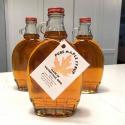
DRoseum - I'm looking at your burners trying to see if I can apply that to my setup.
Was it difficult to set up those Dante NG air/gas mixers? I found documentation that their mixer is rated for an input of 25,000 Btu. is that all you're getting out of your 3 burners? I was hoping for double that per burner.
Do you think I could make my own burner using pipe, a T, 2 elbows, and 2 caps? Not sure how I'd know how many and what diameter holes to drill in the pipe.
Last edited by jdircksen; 03-20-2019 at 02:08 PM.
2021: 28 taps. 18"x36" flat pan and dual natural gas burners.
2020: 31 taps. 3 full size steam table pans on a custom 6x water heater natural gas burner setup.
2019: 31 taps on silvers. Back porch gas cook top with 2 full size steam table pans. An amazing 14.9 gallons in my backyard!
2018: 22 taps on 9 silvers. Propane turkey fryer and full size steam table pan on electric stove. I made 4.25 gallons in my backyard!














 Reply With Quote
Reply With Quote

